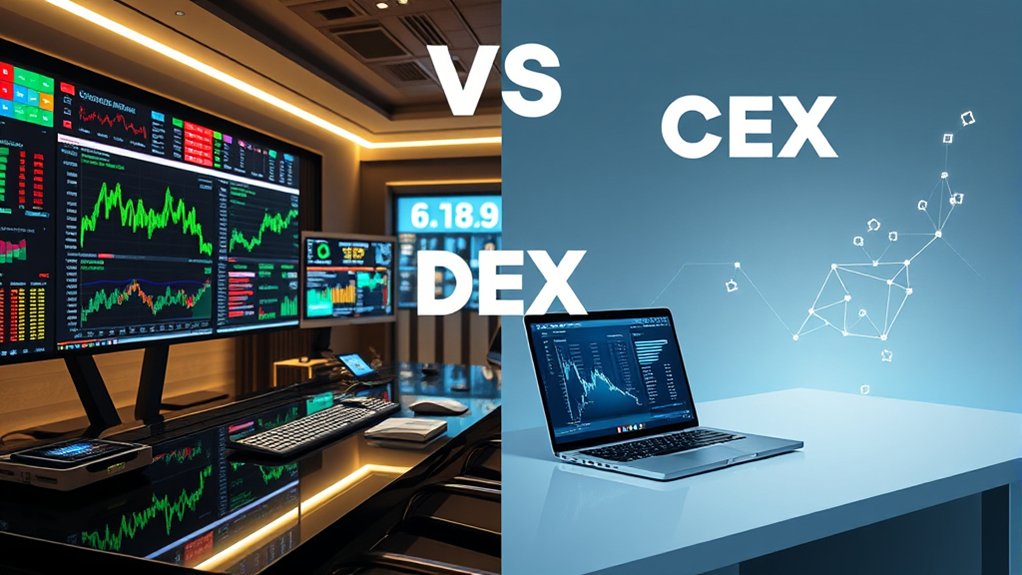Crypto liquidity is like the oxygen of the market—it can’t exist without it. High liquidity means stable prices and less chaos, which is good news for traders. When liquidity plummets, expect wild price swings and manipulation by big investors. Not fun, right? More buyers and sellers boost liquidity, making the whole system smoother. If you care about your investment, understanding liquidity is key. Want to know how it all works? There’s more to uncover.

High liquidity is what keeps the market running smoothly. It creates efficiency and stability. Nobody wants to ride a rollercoaster of volatility because a few whales decided to dump their coins. Low liquidity? That’s a recipe for chaos and price swings that could make even seasoned traders dizzy.
High liquidity keeps the market stable and efficient, preventing wild price swings that can leave traders feeling dizzy.
What makes liquidity tick? It’s all about market participants. The more buyers and sellers in the game, the better. Trading volume also plays a huge role. Lots of trades mean more liquidity. Then there’s market depth. If you look at a depth chart, you can see how many buy and sell orders sit at various price points. Symmetrical order books? Great news. They indicate healthy liquidity. Higher trading volume reflects greater interest in a cryptocurrency, which is crucial for maintaining liquidity. In fact, liquid markets often provide better and fairer prices for market participants. Additionally, during bear markets, investor confidence can significantly impact liquidity as participants are more hesitant to trade.
Now, let’s talk about price stability. High liquidity can keep those prices from doing the cha-cha. Low liquidity? Oh boy, that’s when prices get manipulated by the big fish.
And let’s not forget about market sentiment. When everyone’s feeling good, liquidity can skyrocket. Regulations? They can either help or hurt liquidity, depending on how friendly they are.
And the tech? Advances like Automated Market Makers and liquidity pools are shaking things up. They’re making trading smoother and giving liquidity a boost.
In simple terms, liquidity in crypto is everything. Without it, you’re just left standing there, holding onto a bunch of digital coins that nobody wants. Good luck with that.
Frequently Asked Questions
How Does Liquidity Affect Cryptocurrency Price Volatility?
Liquidity’s a big deal for crypto price volatility. When it’s high, buying and selling happens without sending prices on a rollercoaster ride.
Think of it as a calm sea instead of a storm. Narrow bid-ask spreads? Yup, that means fewer costs and less chaos.
But if liquidity drops, watch out! Volatility spikes like a teenager’s mood swing.
Bottom line: more liquidity equals less drama in crypto pricing. Simple, right?
What Are the Best Platforms for Trading High Liquidity Cryptocurrencies?
When it comes to trading high liquidity cryptocurrencies, a few platforms stand out.
Binance? It’s like the big kid on the block, boasting tons of options and quick trades.
CEX.IO offers decent liquidity too, and it’s got a variety of blockchains.
Bybit? It’s climbing the ranks fast.
And let’s not forget OKX, with its crazy leverage.
If you want action, these places have got you covered. Just don’t forget to read the fine print!
How Can I Assess a Cryptocurrency’s Liquidity?
To assess a cryptocurrency’s liquidity, look at trading volume. High numbers usually mean more action.
Check market depth, too. A robust order book is a good sign.
Don’t ignore bid-ask spreads; narrow ones scream high liquidity.
Oh, and speed matters—sluggish trades can kill your vibe.
Finally, analyze order books to gauge market strength. Simple, right?
Just remember: liquidity can be a fickle friend, so don’t get too cozy!
Do Different Exchanges Have Varying Liquidity Levels?
Absolutely, different exchanges have wildly varying liquidity levels.
Centralized exchanges? They’re the big shots, flaunting deep liquidity thanks to institutional market makers.
Decentralized exchanges, on the other hand, are like that friend who shows up empty-handed—great in theory, but sometimes lacking.
Trading pairs matter too. BTC/USDT? Liquid gold. Lesser-known pairs? Good luck with that.
Can Liquidity Impact Long-Term Investment Strategies?
Liquidity can seriously mess with long-term investment strategies.
Imagine this: if a market’s liquid, prices stay stable. If not, buckle up for volatility. Investors hate that. It means higher transaction costs and a tougher time making quick moves.
Plus, low liquidity? It can scare off big players, which is like a party with no guests.





